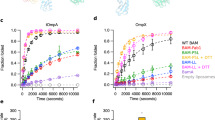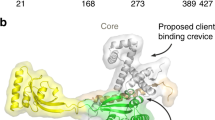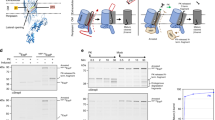Abstract
Perfringolysin O (PFO), a bacterial cholesterol-dependent cytolysin, binds a mammalian cell membrane, oligomerizes into a circular prepore complex (PPC) and forms a 250-Å transmembrane β-barrel pore in the cell membrane. Each PFO monomer has two sets of three short α-helices that unfold and ultimately refold into two transmembrane β-hairpin (TMH) components of the membrane-embedded β-barrel. Interstrand disulfide-bond scanning revealed that β-strands in a fully assembled PFO β-barrel were strictly aligned and tilted at 20° to the membrane perpendicular. In contrast, in a low temperature–trapped PPC intermediate, the TMHs were unfolded and had sufficient freedom of motion to interact transiently with each other, yet the TMHs were not aligned or stably hydrogen bonded. The PFO PPC-to-pore transition therefore converts TMHs in a dynamic folding intermediate far above the membrane into TMHs that are hydrogen bonded to those of adjacent subunits in the bilayer-embedded β-barrel.
This is a preview of subscription content, access via your institution
Access options
Subscribe to this journal
Receive 12 print issues and online access
$259.00 per year
only $21.58 per issue
Buy this article
- Purchase on Springer Link
- Instant access to full article PDF
Prices may be subject to local taxes which are calculated during checkout





Similar content being viewed by others
References
Tweten, R.K. Cholesterol-dependent cytolysins, a family of versatile pore-forming toxins. Infect. Immun. 73, 6199–6209 (2005).
Hotze, E.M. & Tweten, R.K. Membrane assembly of the cholesterol-dependent cytolysin pore complex. Biochim. Biophys. Acta 1818, 1028–1038 (2012).
Rossjohn, J., Feil, S.C., Mckinstry, W.J., Tweten, R.K. & Parker, M.W. Structure of a cholesterol-binding, thiol-activated cytolysin and a model of its membrane form. Cell 89, 685–692 (1997).
Ramachandran, R., Heuck, A.P., Tweten, R.K. & Johnson, A.E. Structural insights into the membrane-anchoring mechanism of a cholesterol-dependent cytolysin. Nat. Struct. Biol. 9, 823–827 (2002).
Ramachandran, R., Tweten, R.K. & Johnson, A.E. The domains of a cholesterol-dependent cytolysin undergo a major FRET-detected rearrangement during pore formation. Proc. Natl. Acad. Sci. USA 102, 7139–7144 (2005).
Czajkowsky, D.M., Hotze, E.M., Shao, Z. & Tweten, R.K. Vertical collapse of a cytolysin prepore moves its transmembrane β-hairpins to the membrane. EMBO J. 23, 3206–3215 (2004).
Shepard, L.A. et al. Identification of a membrane-spanning domain of the thiol-activated pore-forming toxin Clostridium perfringens perfringolysin O: an α-helical to β-sheet transition identified by fluorescence spectroscopy. Biochemistry 37, 14563–14574 (1998).
Shatursky, O. et al. The mechanism of membrane insertion for a cholesterol-dependent cytolysin: a novel paradigm for pore-forming toxins. Cell 99, 293–299 (1999).
Tilley, S.J., Orlova, E.V., Gibert, R.J.C., Andrew, P.W. & Saibil, H.R. Structural basis of pore formation by the bacterial toxin pneumolysin. Cell 121, 247–256 (2005).
Schulz, G.E. The structure of bacterial outer membrane proteins. Biochim. Biophys. Acta 1565, 308–317 (2002).
Reboul, C.F., Mahmood, K., Whisstock, J.C. & Dunstone, M.A. Predicting giant transmembrane β-barrel architecture. Bioinformatics 28, 1299–1302 (2012).
Ohno-Iwashita, Y., Iwamoto, M., Ando, S. & Iwashita, S. Effect of lipidic factors on membrane cholesterol topology—mode of binding of θ-toxin to cholesterol in liposomes. Biochim. Biophys. Acta 1109, 81–90 (1992).
Heuck, A.P., Hotze, E.M., Tweten, R.K. & Johnson, A.E. Mechanism of membrane insertion of a multimeric β-barrel protein: perfringolysin O creates a pore using ordered and coupled conformational changes. Mol. Cell 6, 1233–1242 (2000).
Nelson, L.D., Johnson, A.E. & London, E. How the interaction of perfringolysin O with membranes is controlled by sterol structure, lipid structure, and physiological low pH: insights into the origin of perfringolysin O–lipid raft interaction. J. Biol. Chem. 283, 4632–4642 (2008).
Flanagan, J.J., Tweten, R.K., Johnson, A.E. & Heuck, A.P. Cholesterol exposure at the membrane surface is necessary and sufficient to trigger perfringolysin O binding. Biochemistry 48, 3977–3987 (2009).
Nelson, L.D., Chiantia, S., London, E. & Perfringolysin, O. Association with ordered lipid domains: implications for transmembrane protein raft affinity. Biophys. J. 99, 3255–3263 (2010).
Farrand, A.J., LaChapelle, S., Hotze, E.M., Johnson, A.E. & Tweten, R.K. Only two amino acids are essential for cytolytic toxin recognition of cholesterol at the membrane surface. Proc. Natl. Acad. Sci. USA 107, 4341–4346 (2010).
Soltani, C.E., Hotze, E.M., Johnson, A.E. & Tweten, R.K. Specific protein-membrane contacts are required for prepore and pore assembly by a cholesterol-dependent cytolysin. J. Biol. Chem. 282, 15709–15716 (2007).
Soltani, C.E., Hotze, E.M., Johnson, A.E. & Tweten, R.K. Structural elements of the cholesterol-dependent cytolysins that are responsible for their cholesterol-sensitive membrane interactions. Proc. Natl. Acad. Sci. USA 104, 20226–20231 (2007).
Dowd, K.J. & Tweten, R.K. The cholesterol-dependent cytolysin signature motif: a critical element in the allosteric pathway that couples membrane binding to pore assembly. PLoS Pathog. 8, e1002787 (2012).
Ramachandran, R., Tweten, R.K. & Johnson, A.E. Membrane-dependent conformational changes initiate cholesterol-dependent cytolysin oligomerization and intersubunit β-strand alignment. Nat. Struct. Mol. Biol. 11, 697–705 (2004).
Hotze, E.M. et al. Monomer-monomer interactions propagate structural transitions necessary for pore formation by the cholesterol-dependent cytolysins. J. Biol. Chem. 287, 24534–24543 (2012).
Harrison, P.M. & Sternberg, M.J. Analysis and classification of disulphide connectivity in proteins. The entropic effect of cross-linkage. J. Mol. Biol. 244, 448–463 (1994).
Shepard, L.A., Shatursky, O., Johnson, A.E. & Tweten, R.K. The mechanism of pore assembly for a cholesterol-dependent cytolysin: formation of a large prepore complex precedes the insertion of the transmembrane β-hairpins. Biochemistry 39, 10284–10293 (2000).
Hotze, E.M. et al. Arresting pore formation of a cholesterol-dependent cytolysin by disulfide trapping synchronizes the insertion of the transmembrane β-sheet from a prepore intermediate. J. Biol. Chem. 276, 8261–8268 (2001).
Heuck, A.P., Tweten, R.K. & Johnson, A.E. Assembly and topography of the prepore complex in cholesterol-dependent cytolysins. J. Biol. Chem. 278, 31218–31225 (2003).
Wessel, D. & Flügge, U.L. A method for the quantitative recovery of protein in dilute solution in the presence of detergents and lipids. Anal. Biochem. 138, 141–143 (1984).
Chou, K.C. et al. Energetics of the structure and chain tilting of antiparallel β-barrels in proteins. Proteins 8, 14–22 (1990).
Sansom, M.S. & Kerr, I.D. Transbilayer pores formed by β-barrels: molecular modeling of pore structures and properties. Biophys. J. 69, 1334–1343 (1995).
Chou, K.C. & Scheraga, H.A. Origin of the right-handed twist of β-sheets of poly(lVal) chains. Proc. Natl. Acad. Sci. USA 79, 7047–7051 (1982).
Crowley, K.S., Reinhart, G.D. & Johnson, A.E. The signal sequence moves through a ribosomal tunnel into a noncytoplasmic aqueous environment at the ER membrane early in translocation. Cell 73, 1101–1115 (1993).
Johnson, A.E. Fluorescence approaches for determining protein conformations, interactions, and mechanisms at membranes. Traffic 6, 1078–1092 (2005).
Song, L. et al. Structure of staphylococcal α-hemolysin, a heptameric transmembrane pore. Science 274, 1859–1866 (1996).
Neupert, W. & Herrmann, J.M. Translocation of proteins into mitochondria. Annu. Rev. Biochem. 76, 723–749 (2007).
Chacinska, A., Koehler, C.M., Milenkovic, D., Lithgow, T. & Pfanner, N. Importing mitochondrial proteins: machineries and mechanisms. Cell 138, 628–644 (2009).
Endo, T. & Yamano, K. Transport of proteins across or into the mitochondrial outer membrane. Biochim. Biophys. Acta 1803, 706–714 (2010).
Hagan, C.L., Silhavy, T.J. & Kahne, D. β-Barrel membrane protein assembly by the Bam complex. Annu. Rev. Biochem. 80, 189–210 (2011).
Heuck, A.P., Savva, C.G., Holzenburg, A. & Johnson, A.E. Conformational changes that effect oligomerization and initiate pore formation are triggered throughout perfringolysin O upon binding to cholesterol. J. Biol. Chem. 282, 22629–22637 (2007).
Ye, J., Esmon, N.L., Esmon, C.T. & Johnson, A.E. The active site of thrombin is altered upon binding to thrombomodulin: Two distinct structural changes are detected by fluorescence, but only one correlates with protein C activation. J. Biol. Chem. 266, 23016–23021 (1991).
Acknowledgements
Support was provided by US National Institutes of Health grant AI-37657 (R.K.T.) and Robert A. Welch Foundation Chair grant BE-0017 (A.E.J.).
Author information
Authors and Affiliations
Contributions
T.K.S. did experiments and contributed to experimental design and writing text, and A.E.J. and R.K.T. contributed to experimental design and writing text.
Corresponding author
Ethics declarations
Competing interests
The authors declare no competing financial interests.
Supplementary information
Supplementary Text and Figures
Supplementary Results (PDF 9231 kb)
Rights and permissions
About this article
Cite this article
Sato, T., Tweten, R. & Johnson, A. Disulfide-bond scanning reveals assembly state and β-strand tilt angle of the PFO β-barrel. Nat Chem Biol 9, 383–389 (2013). https://doi.org/10.1038/nchembio.1228
Received:
Accepted:
Published:
Issue Date:
DOI: https://doi.org/10.1038/nchembio.1228
This article is cited by
-
Visualizing the Domino-Like Prepore-to-Pore Transition of Streptolysin O by High-Speed AFM
The Journal of Membrane Biology (2023)
-
Inerolysin and vaginolysin, the cytolysins implicated in vaginal dysbiosis, differently impair molecular integrity of phospholipid membranes
Scientific Reports (2019)
-
Conformational folding and disulfide bonding drive distinct stages of protein structure formation
Scientific Reports (2018)
-
Cholesterol-dependent cytolysins: from water-soluble state to membrane pore
Biophysical Reviews (2018)
-
Structure of the poly-C9 component of the complement membrane attack complex
Nature Communications (2016)



